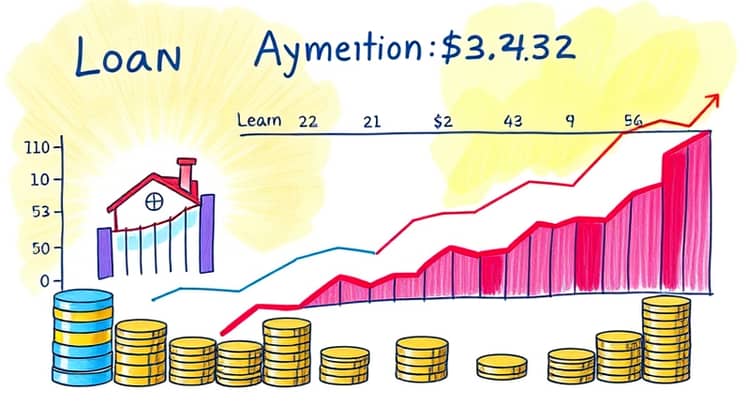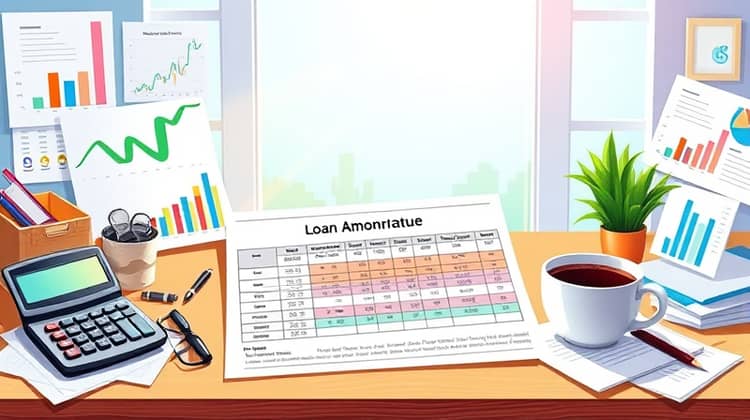Loan amortization is a key concept in personal finance, especially for those considering taking a loan for purchasing a home, car, or any other significant investment. This method allows borrowers to understand how their payments are structured over the term of their loan, ensuring easier budgeting and financial planning. In this article, we will delve into loan amortization, its mechanisms, types, advantages, disadvantages, and its relationship with interest rates.
What is Loan Amortization?

Loan amortization refers to the process of paying off a debt over time through regular payments. For most loans, these payments are made on a monthly basis and consist of both principal and interest. By the end of the loan period, the borrower has fully repaid the amount borrowed along with accrued interest. This systematic repayment approach simplifies financial management for both lenders and borrowers.
The amortization process can be visualized as a decreasing burden on the borrower, as each payment reduces the principal. At the beginning of the loan term, a larger portion of each payment goes towards interest costs, while a smaller portion pays down the principal. However, as the loan matures, the trend reverses, with more of the payment going towards the principal.
Loan amortization is not limited to real estate mortgages; it can apply to various types of loans such as personal loans, auto loans, and student loans. Each of these loan types has its distinct amortization structures based on the interest rates and terms laid out in the original loan agreement.
Understanding loan amortization is vital for prospective borrowers since it provides clarity on how much they will pay in total over the loan duration. This allows one to make informed decisions when it comes to loan amounts, terms, and overall financial strategy.
How Does Loan Amortization Work?

Loan amortization functions through the systematic allocation of each monthly payment towards both principal and interest. The exact distribution of these payments can be illustrated in an amortization schedule, which provides visibility into how much the borrower pays monthly throughout the loan's duration.
A fundamental principle in amortization is that borrowers initially pay more interest than principal. This is due to how interest is calculated based on the outstanding loan balance. As the balance decreases with each payment, the amount of interest accrued also reduces, allowing more of the payment to go towards reducing the loan principal in later stages of the loan.
The calculations involved in determining the amortization schedule account for the loan amount, interest rate, and loan term. This helps to ensure that the loan will be paid off in full after the agreed-upon number of payments. Borrowers can often choose from various payment frequencies, although monthly payments remain the most common.
In essence, loan amortization allows borrowers to visualize their repayment journey. It highlights how their debt decreases over time, providing a roadmap that can help in managing and reassessing personal finances along the way.
Why is Amortization Important?

Amortization is crucial as it ensures borrowers understand their repayment obligations. By knowing exactly how much they will pay each month, individuals can create more accurate budgets and avoid surprises that may arise from fluctuating payment amounts. This stability can lead to better financial health and planning.
Additionally, understanding amortization can help borrowers decide when to refinance or pay off a loan early. With insights gained from amortization schedules, one can calculate the most cost-effective strategies for managing their debt. Knowing how much interest one will pay over the life of the loan can inform these decisions significantly.
Types of Loan Amortization

There are primarily two types of loan amortization: fixed-rate amortization and variable-rate amortization. In fixed-rate amortization, the interest rate remains constant throughout the life of the loan, leading to consistent monthly payments. This is the most common amortization type, widely used for mortgages.
Conversely, variable-rate amortization means the interest rate can change, usually based on market conditions. This can result in fluctuating payment amounts, making budgeting more challenging for borrowers; however, it may lead to lower costs if interest rates decrease.
Understanding these variations can help borrowers select loans that best meet their financial circumstances and risk tolerance.
* Fixed-rate amortization: Constant interest rate and fixed payments. * Variable-rate amortization: Fluctuating interest rates resulting in changing payment amounts.
- Fixed-rate amortization: Constant payments throughout the loan term.
- Variable-rate amortization: Payments may change depending on interest rate fluctuations.
Choosing between these types of amortization is critical for managing financial risk while achieving long-term financial goals.
How to Calculate Loan Amortization

Calculating loan amortization typically involves finding the monthly payment amount, which can be done using an amortization formula: P = [r*PV] / [1 - (1 + r)^-n]. Here, P represents the monthly payment, r is the monthly interest rate, PV is the present value (or principal amount), and n is the total number of payments.
Using this formula, borrowers can quickly gauge their expected monthly outlay when considering different loan terms and amounts. Additionally, many online calculators are available to simplify this process, allowing for adjustable variables to reflect potential changes in interest rates or loan structure.
- Use the loan amortization formula to calculate monthly payments.
- Use online amortization calculators for quick estimates.
Access to these calculation tools enhances borrowers' financial literacy and empowers them to make informed decisions based on expected repayment terms and amounts.
Loan Amortization Schedules

A loan amortization schedule is a detailed table that breaks down each payment over the life of the loan. It typically includes the payment number, payment amount, principal paid, interest paid, and remaining balance. This structured display gives borrowers a clear view of how their payments affect their outstanding balance.
With a comprehensive amortization schedule, borrowers can see how the balance decreases over time and how much interest they will pay each period. This transparency encourages financial planning, helping borrowers strategize when to potentially pay off loans prematurely or refinance. A well-structured schedule can also serve as a critical tool for managing financial accountability.
Creating an amortization schedule can be done manually through calculations or using various online tools tailored to generate these schedules in real-time. Many borrowers find it beneficial to review their amortization schedules annually to track their progress and make any necessary adjustments to their payment strategies.
Advantages of Loan Amortization

The primary advantage of loan amortization is that it allows borrowers to predict their payments accurately. This predictability makes budgeting straightforward and helps ensure that individuals can meet their financial obligations without unnecessary stress.
- Simplifies budgeting and payment predictability.
- Enhances financial understanding and decision-making.
- Facilitates the identification of prepayment strategies.
This structure promotes informed financial management and helps in decreasing anxiety associated with loan repayment.
Disadvantages of Loan Amortization

Despite its several advantages, loan amortization also has some drawbacks. One significant disadvantage arises in the early stages of the loan, where a greater portion of the payment goes toward interest rather than the principal amount, leading to slower debt reduction.
Another drawback is that if a borrower wishes to refinance or pay off the loan early, they may face prepayment penalties, limiting their ability to save on interest payments.
- Initial payments consist mainly of interest rather than principal reduction.
- Potential prepayment penalties can limit refinancing options.
These limitations necessitate careful consideration of the mortgage terms and the financial context in which the loan is being taken.
Amortization and Interest Rates

Interest rates play a crucial role in the loan amortization process. When rising, they can lead to increased monthly payments, particularly in variable-rate loans. This fluctuation can affect budgeting and financial planning for borrowers, making amortization schedules vital during periods of economic uncertainty.
Conversely, lower interest rates can significantly reduce total repayment amounts, making borrowing more attractive for consumers. Understanding how different rates affect amortization can help borrowers choose strategically when to take on debt or refinance existing loans.
In summary, staying informed about interest rate trends can empower borrowers to make smarter financial choices regarding their loans and overall financial health.
Conclusion

In conclusion, loan amortization is an essential concept that provides clarity and structure to the repayment process. By breaking down payments into manageable parts, consumers can better navigate their finances and make informed decisions about borrowing. Understanding the mechanics of loan amortization, types, calculations, and its relationship with interest rates allows borrowers to utilize it to their advantage.
As you move forward in your financial planning, remembering the importance of loan amortization can help you establish more secure and positive financial outcomes. With knowledge comes power over your financial decisions, enabling you to leverage loans more effectively and sustainably.














